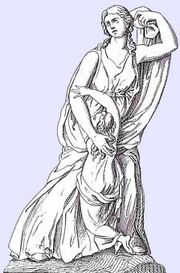
Niobe and her children, from the Uffizi Gallery..
In Greek mythology, the Niobids were the children of Amphion of Thebes and Niobe, slain by Apollo and Artemis because Niobe, born of the royal house of Phrygia, had boastfully compared the greater number of her own offspring with those of Leto, Apollo's and Artemis' mother: a classic example of hubris.[1]
The number of Niobids mentioned most usually numbered twelve (Homer) or fourteen (Euripides and pseudo-Apollodorus), but other sources mention twenty,[2] four (Herodotus), or eighteen (Sappho). Generally half these children were sons, the other half daughters. The names of some of the children are mentioned; these lists vary by author:
- Apollodorus:[3] Agenor, Astycratia, Astyoche, Cleodoxa, Damasichthon, Eupinytus, Ismenus, Neaera, Ogygia, Pelopia, Phaedimus, Phthia, Phylomache, Sipylus, Tantalus
- Hyginus:[4] Archenor, Astycratia, Astynome, Chias, Chloris, Cleodoxa, Damasichthon, Eudoxa, Eupinytus, Ismenus, Neaera, Ogygia, Phaedimus, Phthia, Sipylus, Tantalus, Thera
- Ovid:[5] Alphenor, Damasichthon, Ilioneus, Ismenus, Phaedimus, Sipylus, Tantalus.
Mante, the seeress daughter of Tiresias, overheard Niobe's remark and bid the Theban women placate Leto, in vain. Apollo and Artemis slew them all with their arrows, Apollo shooting the sons, Artemis the daughters. Two of the Niobids who had supplicated Leto were spared, Meliboea (Chloris)[6] and Amyclas. They were buried by the gods at Thebes. Ovid remarked[7] that all men mourned Amphion, for the extinction of his line, but none mourned Niobe save her brother Pelops.
Variant myth[]
In another version of the myth, the Niobids are the children of Philottus and Niobe, daughter of Assaon. Assaon made advances to her which she refused. He then invited her children to a banquet and burnt them all to death. Philottus had perished whilst hunting. As a result of these calamities, she flung herself from a high rock. Assaon, reflecting over his crimes, also killed himself.[8]
Art[]
Due to their appearance in the mythology of Apollo, male and female Niobids frequently appeared in classical art. One of the two ivory reliefs added to the doors of the Temple of Apollo Palatinus in its Augustan rebuild depicted their death.[9] They are also known from figurative sculpture, examples of which are to be found at the Palazzo Massimo in Rome and in the group of Niobids (including Niobe sheltering one of her daughters) found in Rome in 1583 along with the Wrestlers and brought to the Uffizi in Florence in 1775.[10]
In popular culture[]
The novels Niobe and Pelops: Children of Tantalus, Niobe and Amphion: The Road to Thebes and Niobe and Chloris: Arrows of Artemis by Victoria Grossack and Alice Underwood, set in Greece's Bronze Age, posit another solution to the cause of death of the Niobids. Although Apollo and Artemis are given the blame, the mass murderer is a mortal grappling for power.
References[]
- ↑ Robert Graves, The Greek Myths, 1960, §77.
- ↑ A number attributed to Hesiod by various scholiasts (Graves 1960:259.
- ↑ Apollodorus. The Library, 3.5.6.
- ↑ Hyginus. Fabulae, 11,69.
- ↑ Ovid. Metamorphoses, 6.255ff.
- ↑ Meliboëahad turned so pale with fear that she was still nicknamed Chloris when she married Neleus some years later." (Graves 1960:259).
- ↑ Ovid. Metamorphoses, VI.401-04.
- ↑ Apollodorus; Nonnus, Dionysiaca.
- ↑ Propertius, II.31.12‑16.
- ↑ Uffizi Gallery - The Portrait, Baroccio And Niobe Rooms.
| This page uses content from the English Wikipedia. The original article was at Niobids. The list of authors can be seen in the page history. |